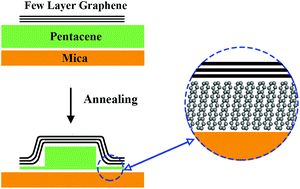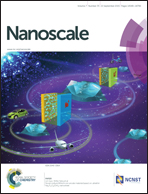A pentacene monolayer trapped between graphene and a substrate†
Abstract
A self-assembled pentacene monolayer can be fabricated between the solid–solid interface of few-layered graphene (FLG) and the mica substrate, through a diffusion-spreading method. By utilizing a transfer method that allows us to sandwich pentacene between graphene and mica, followed by controlled annealing, we enabled the diffused pentacene to be trapped in the interfaces and led to the formation of a stable monolayer. We found that the formation of a monolayer is kinetically favored by using a 2D Ising lattice gas model for pentacene trapped between the graphene–substrate interfaces. This kinetic Monte Carlo simulation results indicate that, due to the graphene substrate enclosure, the spreading of the first layer proceeds faster than the second layer, as the kinetics favors the filling of voids by molecules from the second layer. This graphene assisted monolayer assembly method provides a new avenue for the fabrication of two-dimensional monolayer structures.


 Please wait while we load your content...
Please wait while we load your content...